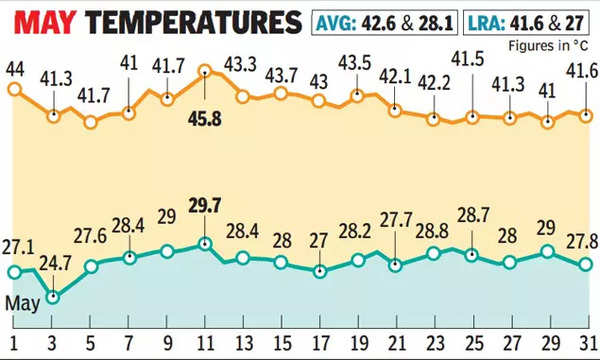- News
- City News
- ahmedabad News
- 68 days of 40 degree Celsius: One of the hottest summers in Ahmedabad
68 days of 40 degree Celsius: One of the hottest summers in Ahmedabad

Representative image
AHMEDABAD: Since March 24, the city recorded only one day of maximum temperature below 40 degrees celsius - making it one of the hottest summers in the past one decade with 68 days of continuous high temperatures.

The India Meteorological Department (IMD) on Tuesday released a report of May and forecast of June where north Gujarat and Kutch were the two regions with above normal maximum temperatures, whereas almost entire state was marked for the above normal minimum temperatures.
According to IMD data, the long-range average (LRA) for maximum and minimum temperatures for Ahmedabad were 41.6 degrees celsius and 27 degrees respectively. This year, the city recorded average temperatures of 42.6 degrees and 28.1 degrees respectively. The city also recorded 45.8 degrees celsius maximum temperature on May 11, which was the second hottest in the past 10 years. The month, however, was a bit cooler than April which recorded much higher than average temperatures.
The impact of southwesterly winds in the second half of the month helped bring the temperatures down, said the Met department officials.
Manorama Mohanty, the IMD Gujarat chief, said that rather than the overall temperatures, what sets 2022 apart is the continuous high temperatures.
"Over the years, we see variation in the temperatures with gaps between heatwaves. This year, we saw the waves in succession along with temperature not going below 40 degrees since end of March. Thus, it makes the year one of the hottest," she said, adding that the IMD forecast has indicated relatively cooler period in June.
The IMD forecast for monsoon has also predicted a normal monsoon for Gujarat this year.
'Southwest monsoon seasonal (June to September) rainfall over the country is most likely to be normal (96% to 104% of long-period average (LPA). Monsoon seasonal rainfall over the four homogeneous rainfall region is most likely to be above Normal for Central India (>106% of LPA) and South Peninsula (>106% of LPA),' mentioned the IMD release, adding that La Nina conditions are likely to continue over the equatorial Pacific Ocean.

The India Meteorological Department (IMD) on Tuesday released a report of May and forecast of June where north Gujarat and Kutch were the two regions with above normal maximum temperatures, whereas almost entire state was marked for the above normal minimum temperatures.
According to IMD data, the long-range average (LRA) for maximum and minimum temperatures for Ahmedabad were 41.6 degrees celsius and 27 degrees respectively. This year, the city recorded average temperatures of 42.6 degrees and 28.1 degrees respectively. The city also recorded 45.8 degrees celsius maximum temperature on May 11, which was the second hottest in the past 10 years. The month, however, was a bit cooler than April which recorded much higher than average temperatures.
The impact of southwesterly winds in the second half of the month helped bring the temperatures down, said the Met department officials.
Manorama Mohanty, the IMD Gujarat chief, said that rather than the overall temperatures, what sets 2022 apart is the continuous high temperatures.
"Over the years, we see variation in the temperatures with gaps between heatwaves. This year, we saw the waves in succession along with temperature not going below 40 degrees since end of March. Thus, it makes the year one of the hottest," she said, adding that the IMD forecast has indicated relatively cooler period in June.
The IMD forecast for monsoon has also predicted a normal monsoon for Gujarat this year.
'Southwest monsoon seasonal (June to September) rainfall over the country is most likely to be normal (96% to 104% of long-period average (LPA). Monsoon seasonal rainfall over the four homogeneous rainfall region is most likely to be above Normal for Central India (>106% of LPA) and South Peninsula (>106% of LPA),' mentioned the IMD release, adding that La Nina conditions are likely to continue over the equatorial Pacific Ocean.
FOLLOW US ON SOCIAL MEDIA
FacebookTwitterInstagramKOO APPYOUTUBE
Looking for Something?

Start a Conversation
end of article
Visual Stories
Quick Links
UP NewsDelhi TemperatureChennai WeatherBangalore TemperatureMoose wala DeathCoronavirus in DelhiRTPCR test in GurgaonHyderabad RainPollution level in BangaloreDelhi SmogDelhi TemperatureNoida AQIGurgaon AQI todayFire in MumbaiMumbai RainsCovid 19 RT PCR Test in NoidaDelhi AQI todaySrinagar encounter

